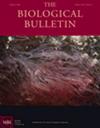Factors Modulating the Female Reproductive Performance of the Fiddler Crab Leptuca uruguayensis with Short Reproductive Season
IF 1.9
4区 生物学
Q2 BIOLOGY
引用次数: 2
Abstract
This study aimed to evaluate the factors modulating the female reproductive performance of the fiddler crab Leptuca uruguayensis (Nobili, 1901) during the short reproductive season of a temperate population. We proposed two modulating factors: the age of females (young and old) and the periods of the reproductive season (beginning, middle, and end); we then evaluated the fecundity, reproductive output, egg volume, and biochemical composition of eggs. The fecundity of L. uruguayensis was affected by the size of females, a variable related to their age. Although young females showed lower fecundity, the reproductive output was not affected by the age or by the periods of the reproductive season, suggesting a constant reproductive effort, proportional to female size. The egg volume decreased, and carotenoid content increased at the end of the season for both female ages, probably as a consequence of variations in food availability and changes in the breeding strategies during the season. However, the content of protein and lipids in the egg clutches decreased at the end of the season only in old females spawning for the second time in the season. The main differences in the reproductive parameters were recorded between the beginning and the end of the reproductive season, probably because in these periods females exclusively use one of the breeding strategies. Finally, we determined that both factors, that is, female age and the periods of the short reproductive season, can modulate the reproductive performance of L. uruguayensis in temperate estuaries.短繁殖季招潮蟹雌性繁殖性能的调节因素
本研究旨在评估在温带种群的短繁殖季节内,影响乌瓜延纤螯蟹(Nobili,1901)雌性繁殖性能的因素。我们提出了两个调节因素:雌性的年龄(年轻和老年)和繁殖季节的时期(开始、中期和结束);然后我们评估了卵子的繁殖力、生殖产量、卵子体积和生化成分。乌拉圭乳杆菌的繁殖力受雌性大小的影响,这是一个与年龄有关的变量。尽管年轻的雌性表现出较低的繁殖力,但繁殖产量不受年龄或繁殖季节的影响,这表明繁殖努力与雌性体型成正比。在季节结束时,两个年龄段的雌性的卵子数量减少,类胡萝卜素含量增加,这可能是由于季节内食物供应的变化和繁殖策略的变化。然而,只有在本季第二次产卵的老雌性中,卵包中的蛋白质和脂质含量在本季末才有所下降。生殖参数的主要差异记录在生殖季节开始和结束之间,可能是因为在这些时期,雌性只使用其中一种繁殖策略。最后,我们确定,雌性年龄和繁殖季节短这两个因素都可以调节乌拉圭乳杆菌在温带河口的繁殖性能。
本文章由计算机程序翻译,如有差异,请以英文原文为准。
求助全文
约1分钟内获得全文
求助全文
来源期刊

Biological Bulletin
生物-海洋与淡水生物学
CiteScore
3.30
自引率
6.20%
发文量
47
审稿时长
6-12 weeks
期刊介绍:
The Biological Bulletin disseminates novel scientific results in broadly related fields of biology in keeping with more than 100 years of a tradition of excellence. The Bulletin publishes outstanding original research with an overarching goal of explaining how organisms develop, function, and evolve in their natural environments. To that end, the journal publishes papers in the fields of Neurobiology and Behavior, Physiology and Biomechanics, Ecology and Evolution, Development and Reproduction, Cell Biology, Symbiosis and Systematics. The Bulletin emphasizes basic research on marine model systems but includes articles of an interdisciplinary nature when appropriate.
 求助内容:
求助内容: 应助结果提醒方式:
应助结果提醒方式:


